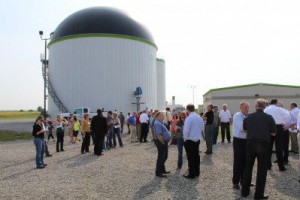CARDINGTON, Ohio — “Everybody take a big, deep breath. … and hold it.”
Those were the instructions Patricia Davies, director of operations at the Morrow County Development Office, gave at the dedication ceremony for a new anaerobic digester Sept. 20 near Cardington.
While that breath of air had obvious hints of a livestock farm, it was also surprisingly fresh, thanks to the waste being contained inside the massive digester to Davies’ far left.
Her enthusiasm was clear.
“We are the land of opportunity,” she said. “We are strengthened by this progressive agriculture and here in Morrow County we love life and we live rural and we’re proud of it.”
The digester was brought into operation this spring, thanks in part to funding through the U.S. Department of Agriculture’s Rural Energy for America Program. It produces enough electric for the local farm, owned by Ringler Farms, and exports enough electric to power about 500 residential homes.
Background
The digester, installed by quasar energy group of Cleveland, works by converting livestock and municipal waste into usable energy — in this case electric. Digesters provide electric and natural gas potential, and reduce greenhouse gas emissions from waste.
Ringler Farms raises market hogs from farrow to finish in Ohio, Pennsylvania and Indiana. The company operates multiple divisions, including Ringler Energy — an alternative energy company.
“We take roughly 4 million gallons of hog manure that would normally be held in outside earthen lagoons and now that manure never gets the light of day,” said Ringler Energy President Alex Ringler. “It is economically viable and, of course, environmentally conscious.”
The digester is a way for him to sustain his third-generation farm for the next generation of Ringlers — his sons. It also diverts wastes out of landfills and fields, and provides a renewable source of energy.
“What society makes, we repurpose, and we create an asset from a liability,” he said.
After digestion, the farm is left with a mostly odorless fertilizer product that quasar calls “equate.” This is applied to fields similarly to manure, and provides an organic source of field nutrients.
Another landmark
Ohio Agriculture Director David Daniels said digesters are “another landmark” in Ohio’s agriculture story, and a good example that agriculture is a diverse science, with many different job opportunities.
“There is an opportunity out there (in agriculture) for everybody that has a different idea of what they want to do and what they want their life’s work to be,” he said. “There’s an agricultural piece in it for you.”
The facility was built in part with a $500,000 U.S. Department of Agriculture grant, and a $2.75 million loan guarantee that must be paid back.
Ringler employs 100-150 people across all of its divisions. The company plans to begin construction on a compressed natural gas station off of Interstate 71, at the state Route 61 exit, by the end of this year.
Alex Ringler declined to specify the rate of return on the digester, but said “it’s a good financial investment. It’s stable.”
In addition to generating electric for the local grid, managed by Consolidated Electric Cooperative, the farm will collect tipping fees based on the amount of wastes collected from local suppliers.
Profit center
Tony Logan, Ohio’s USDA rural development director, called it “a perfect example of how new technologies can be used to create another profit center for farming.”
More digesters
Rural developers and energy companies want to see more digesters built.Only half of a percent of all eligible farms have installed digesters, according to Allison Costa, AgSTAR Program Manager with the U.S. EPA. About 6 percent of financially eligible dairy farms have digesters, she said.
Costa said the Ringler facility offsets greenhouse gas emissions to the equivalent of 180,000 propane tanks for residential gas grills.
Plan carefully
While digesters are exciting, and rewarding, they’re also a big responsibility. They require startup dollars, and a good maintenance plan.“It’s a simple process but there are many components,” Alex Ringler said. “You can build it all day long, but you’ve got to be able to operate it.”
Dick Isler, executive vice president of Ohio Pork Producers Council, said digesters are one more way Ohio’s pork producers are becoming more efficient, and reducing their ecological footprint.
Today, for every pound of pork that’s produced, producers are using 70 percent less land, 41 percent less water, and a 35 percent smaller footprint, he said.
Quasar energy group plans to have 14 operational digesters in the state by the end of the year — which it says will be the most of any state for this type of unit.
STAY INFORMED. SIGN UP!
Up-to-date agriculture news in your inbox!













This is sick and outrageous. Quasar hiding municipal toxic metal human infectious sewage sludge on our ag property and mixing it with hog manures. No one wants human feces on our beautiful Ag land. The only ones that want this are those greedy individuals who are infecting our soil and water. The energy initiative aspect is wonderful, but the sludging of our beautiful soil is wrong and sick. Farmers are DUPED about sewage sludge on our soil. When our soil is so contaminated and toxic, what will they say? Did any of these farmers or Ringling ask if there were any guarantees that this toxic sewage sludge is going to degrade the value of their property in the long run? probably not. So sad that companies like this have to put the American society through this disgusting process. So much for trusting some farmers. They are destroying our soil, water and food. We are farmers too, and would NEVER stoop so low as to use toxic human, industrial waste on our soils. Some day you will weep!
Thanks for your inputs, Jenn. For those interested in Ohio EPA rules and regulations regarding biosolid handling, here is a link with a fact sheet. http://www.epa.state.oh.us/dsw/sludge/biosolid.aspx
Thank you. and for all those who want to know the facts and truths about toxic sewage sludge and how it affects people, food, homes, livestock, our water and our lives: PLEASE visit this link and watch the short video. We are being duped. Too many loopholes and smokescreens. http://www.sludgefacts.org
manure itself isn’t going to hurt the land and if you don’t want the rest of it on your land then don’t use it. Leave everything else up to the people who decide to use it, it’s that simple. Coming from someone who is going to college for the soul purpose of swine production with a dual major in soil management, I have looked over everything associated with this company and have found nothing that is going to hurt anyone or anything as long as it is limited.
If human waste is put in a bio digester doesn’t the bacteria break it down into a safe product? How are the solids removed or is it all broke down into a liquid state? What temperature has to be reached in order to make it safe for use as fertilizer? Does any chemicals have to be added to the digester to make it safe or is it just human and animal waste?